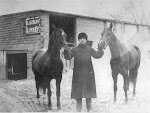Facing the railroad tracks, close to the train depot are three diverse historical buildings that complement Chelsea’s somewhat forgotten industrial neighborhood. They are known as the “Longworth” buildings linked together in Chelsea’s industrial past for the last 100 years. Their presence provides a visual continuity and a sense of place to anyone passing by. Architecture styles range from the commercial brick Victorian of the early 20th century, to Art Moderne of the late 30s and early 40s. One building is a rustic cinder block structure built to be used as a livery and barn.
Mack Building
The oldest middle brick building was constructed in circa 1901. A. R. Welch, with prior Chelsea Manufacturing Co. success in manufacturing bicycles, moved in to build about 10 prototype Welch automobiles. One of the early investors of the Welch Manufacturing Co. was Chelsea banker George P. Glazier and later his son Frank Glazier. The Chelsea-made Welch car was exhibited at the 1903 Chicago Automobile Show. Only four Welch autos are known to exist today; one is displayed at the Henry Ford Museum in Dearborn. After Welch went bankrupt, he left Chelsea, merged with Pontiac continuing to manufacture the Welch and Oakland cars until 1911 when the firm was sold to General Motors Corp.
Glazier Stove Company bought the building in early 1904, using it as building No. 18 to store or assemble Brightest & Best stoves until 1907. The Chelsea Tribune moved in late 1907 and published a new newspaper that year which lasted until 1923. Space was shared with Chelsea Screw Co. starting in 1913, and Chelsea Elevator Co. The Mack Co. of Ann Arbor bought the building in the teens.
Sometime in the 1920s, Warren R. Daniels of Daniels Motor Sales, took over this building. Daniels was a sub-dealer for Dodge Bros. automobiles. He received his first car the day before Thanksgiving in 1917, and sold his first two cars in March of 1918 to Jules Strieter and Herb Paul. In 1925 Daniels was Chelsea’s Buick dealer, and by 1933 he added the Oldsmobile line. It was during Daniel’s ownership in the 1940s that the front Art Moderne car showroom was added. Daniels Motor Sales, Inc. was sold to the Sprague family, and eventually moved south of Chelsea to become the Faist-Morrow Buick dealer.
The second floor is said to have been used by Chelsea Milling Company in the 1930s. Mabel Holmes, the creator of packaged Jiffy mixes, may have packaged some of the first boxed mixes there. Fluorescent light bulbs were once manufactured in the building also.
For many years Longworths loaned the vacated front car showroom and adjoining floor space for various community uses. After Heydlauff’s Frigid Products’ devastating August 1970 fire, Longworths loaned this space for Heydlauff's business to continue business until their new appliance store could be built.
Longworth Plating Plant
The Longworth Plating Co. legacy began in 1946 Marion Longworth in the Clock tower building as a continuation of the industrial plating business which had started previously at the Federal Screw Company. In 1952, Longworth bought the livery building spending three months remodeling it for the industrial plating business. Later on in the decade he acquired the Mack building, with car showroom which had been used by Warren Daniels and later Sprague Motors.
The Heydlauff family business used the showroom for about 6 months in 1970 while their present building was being built . A disastrous fire destroyed their old building in 1970 and the showroom proved very adaptable for their purposes and thus saved their business.
Longworth specialized in industrial electroplating which included decorative auto parts and hand-rack plating using cadmium, nickel, tin, copper, zinc and chromium. They also did barrel and still plating. Plating mechanical components with these metals provided protection against friction, heat, rust and corrosion.
Marion Longworth retired in 1984 during his 38th business year. Longworth Plating was carried on by his son David, and daughter Flo Ann. David’s daughter Kim, and son Kent, represented the third generation in the business. Through the years Longworth’s work force averaged 10 employees, with Homer and Bill Beach working for about 40 years. Ed, Ted and Walter Bennett were a few of the old-time employees. By the closing year 2002, Odis Richardson had worked there 38 years in electroplating.
Chelsea House Livery Building
A few feet east of the Mack building, a Livery stands retaining the last vestiges of Chelsea’s horse and buggy days with its sign “Chelsea House Livery-Feed and 10 Cent Barn.”
John Wagner, proprietor of the Chelsea House Hotel, built this livery in 1905 to replace previous structures that served the same function in the same location. Since 1863, the hotel livery had been a place for customers to park their horses and carriages during their stay in Chelsea. Horses were stabled on the upper floor; feed and carriages were housed on the ground floor.
It appears that Wagner sold the Livery to B. J. Conlan some time in 1911 while he was still the proprietor of Chelsea House. In 1916 Chelsea House was sold and renamed the Crescent Hotel. A 1918 Sanborn map shows the Conlan Livery as a “horse and auto” livery open into early 1920s. The Jones Co. used the building for a used car garage and repair shop into the 1940s. Leigh Palmer of Palmer Motor Sales used the Livery to store cars during World War II.
Interim Livery building uses included a processing warehouse for onions, and wool storage and processing by a man named Alber.
Today the three buildings set quiet and vacant, devoid of noise from industrial machinery or the loading and unloading of supplies. Longworth Plating closed in 2002, selling the property to the City of Chelsea in December of 2008.
Friday, August 21, 2009
Subscribe to:
Post Comments (Atom)


Thank you to the Chelsea Standard for publishing the history of the Longworth Buildings! We look forward to the continued coverage by our hometown paper. Coalition to Save the Livery
ReplyDelete